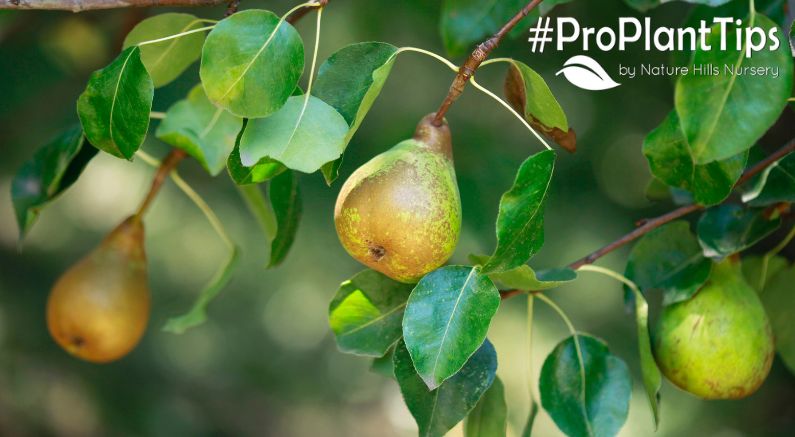Juicy and succulently sweet Pears are a summer and autumn treat! The mellow sweetness and creamy textures are something we all look forward to each year! It's as easy as pie to grow your own Pear tree!

Wild Pear trees (Pyrus) were originally grown and bred in both Europe and Asia. Ancient farmers looked for specimens that had larger, sweeter fruit and bred these parent plants over time. Romans were likely working with about 50 species of improved Pears. By 1860, American author T.W. Fields noted there were about 850 known Pears!
Modern Pear trees are hardy, disease-resistant, and produce mouth-watering fruit. Some tolerate cold climates (USDA zone 4) all the way up to sweltering hardiness zone 11! They bloom in a flourish of fragrant white blossoms and fill out in dark green glossy leaves.
From the tiny Chojuro Pear to the massive 40-foot-tall Oriental Asian Pear, here are some pointers and information to get you started harvesting your very own homegrown goodness, regardless of how much space you can spare!
- Types of Pear Trees
- Pear Seasons
- How To Tell When Pears Are Ripe?
- Enjoying Your Surplus Harvest
- Happy Planting!
Types of Pear Trees

Pears are some of the easiest fruit trees to grow, and there are two main varieties: the European and the Asian. Both types require different harvesting techniques, with differences in storage, cooking, and usage.
Asian Pears
Asian Pears are round like Apples and are large, crisp, crunchy, and loaded with juice. Also known as the Apple Pear, they snap and crunch when you bite into them.
European Pears
European Pears have that characteristic narrow neck. They are softer with a nuanced flavor. Seckel Pear produces very sweet, small Pears used in canning. Comice and D'Anjou are staples in high-end food gift packages and are excellent for fresh eating, baking, canning, and preserving.
Pear Seasons

With today's dizzying array of Pear tree varieties, it may be hard to choose just one! Pears typically ripen between July and October. Choosing varieties across the early, mid, and late seasons extends your harvest so you can enjoy Pears all summer into fall, and even into winter months!
Early Season Pears
Summer Pears ripen in July to August, depending on your climate.
- Hosui – Round like an Apple, flavored like one. Ripens in August.
- Pineapple – Hard yellow cooking Pear. Early August.
- Summercrisp – Blight resistant, very hardy, mid-August harvest.
- Southern Bartlett – Great for hot climates, ripens early.
Mid-Season Pears
Early fall Pears ripen in September, just as the fall colors arrive.
- Blake's Pride European – Aromatic and sweet, September.
- Flemish Beauty European – Melt-in-your-mouth red Pear, September.
- Luscious – Creamy flesh, disease & cold-tolerant, September harvest.
Late Season Pears
Also called Winter Pears, they ripen in cold and frost.
- Korean Giant Asian – Giant, crisp, ripens in October.
- Seckel – Candy or Sugar Pear, stores until February.
- Magness European – Thicker skin, melting flesh, late fall.
Your climate can alter these dates. Check with your County Extension Office and other local gardeners!
How To Tell When Pears Are Ripe?

- Ripening Behavior: Most Pears rarely ripen on the tree and ripen slowly after harvest. Some Summer Pears and Asian Pears do ripen on the tree.
- Ripeness Test: Press the neck near the stem. Look for color, sweet smell, and gentle twist release.
- Testing Indoors: Pick slightly early and let them ripen on the counter or in a brown paper bag.
- Visual Clues: Watch for color changes or a rosy blush. Not all Pears change color! Know your variety!
- Harvest Timing: Don't wait too long. Overripe = mealy/grainy flesh.
- European Pear Rule: Pick when firm, harvest mature but not ripe.
- Speed Up Ripening: Use a brown paper bag with an apple for an ethylene gas boost.
How To Enjoy Your Surplus Harvest

Excellent fresh out of hand and in salads. Try these ideas:
- Sliced on grilled cheese
- Charcuterie board pairing with cheeses
Versatile flavors! They pair with:
- Chocolate & vanilla
- Caramel & maple syrup
- Spices like cinnamon, mint, ginger
- Savory herbs: thyme, rosemary
- Nuts, pork, game
- Red & white wine
Cooking & Baking With Pears
- Grill with olive oil & balsamic vinegar
- Bake into pies, tarts, desserts
- Blend into smoothies
- Churn into ice cream
- Make into sauce (like applesauce)
- Whip up Pear shortbreads
- Blend into pancakes
Preserving & Storing Pears
- Puree into fruit leather
- Pear jelly & jam
- Spiced Pears
- Canned slices in syrup
- Freeze or dry for snacks
Organic Baby Food
Pears make excellent homemade baby food , and you'll know exactly how they were grown!
Bushels of Pears Ahead!
Boost food sustainability and enjoy fresh pesticide-free produce in your backyard! Order your own Pear tree today for edible landscaping and a sweet, juicy harvest. Available in containers and bareroot shipping from NatureHills.com!
Read in-depth planting, care, and pruning info here!
Happy Planting!


